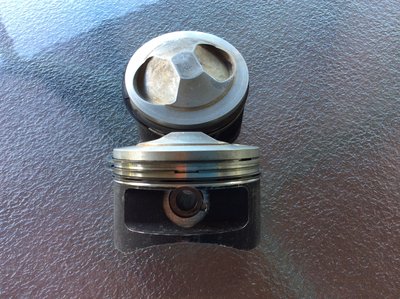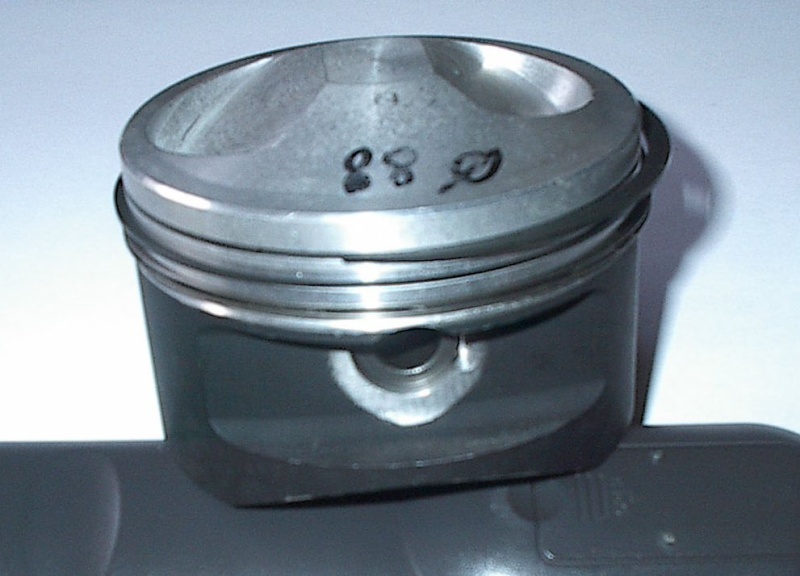|
View unanswered posts | View active topics
| Author |
Message |
|
boucher
|
Post subject: Re: Ducati/cagiva hi comp pistons  Posted: Posted: Sat Sep 12, 2015 4:44 am |
|
Joined: Wed Nov 17, 2010 5:45 am
Posts: 391
|
|
Thanks for everyone's input. Carlo what size valves did you use? 41mm -35mm. At the moment I'm collecting engine parts for the TT1 rep. More to come. Boucher.
|
|
| Top |
|
 |
|
Carlo
|
Post subject: Re: Ducati/cagiva hi comp pistons  Posted: Posted: Sat Sep 12, 2015 5:20 am |
|
Joined: Thu Oct 28, 2010 4:44 am
Posts: 1786
Images: 7
|
|
I used the intake valve 41 mm, and the unloading, when it is available, use the original 38mm suction pantah, reducing it to about 36.5 mm
|
|
| Top |
|
 |
|
boucher
|
Post subject: Re: Ducati/cagiva hi comp pistons  Posted: Posted: Sun Sep 13, 2015 12:03 am |
|
Joined: Wed Nov 17, 2010 5:45 am
Posts: 391
|
|
Thanks Carlo much appreciated! Boucher.
|
|
| Top |
|
 |
|
Carlo
|
Post subject: Re: Ducati/cagiva hi comp pistons  Posted: Posted: Sun Sep 13, 2015 5:54 pm |
|
Joined: Thu Oct 28, 2010 4:44 am
Posts: 1786
Images: 7
|
 boucher wrote: Thanks Carlo much appreciated! Boucher.
|
|
| Top |
|
 |
|
boucher
|
Post subject: Re: Ducati/cagiva hi comp pistons  Posted: Posted: Mon Oct 19, 2015 3:55 am |
|
Joined: Wed Nov 17, 2010 5:45 am
Posts: 391
|
|
Hello from down under, These are a set of f1 750 pistons I'm told. I,m after a approximate answer for an approximate question!! What would the approximate compression ratio be if I used these with the allazurra heads with the larger 41/35 valves? Any approximate answer out there would be much appreciated. Thanks Boucher.
| Attachments: |

image.jpg [ 2.25 MiB | Viewed 1198 times ]
|
|
|
| Top |
|
 |
|
sports
|
Post subject: Re: Ducati/cagiva hi comp pistons  Posted: Posted: Mon Oct 19, 2015 5:02 am |
|
Joined: Wed Mar 21, 2012 9:56 am
Posts: 112
|
|
It can get quite complicated.
The compression ratio is the result of so many variables. It depends primarily on valve overlap figures of the chosen cams, timing figures and lift, diameter of the valve heads (which is known at 41/35). The bigger the valve head, the smaller the passing clearance on the overlap phase. This can mean lifting the whole combustion chamber to allow the valves enough room to miss each other. Maybe even the length of the valve stems may mean lifting the combustion chamber to facilitate the limitation of the range of shims available.
All that said, your pistons have a healthy bump on top so will at least give you something to work with. I would guess in the region of 11.5-1 at best.
|
|
| Top |
|
 |
|
Carlo
|
Post subject: Re: Ducati/cagiva hi comp pistons  Posted: Posted: Mon Oct 19, 2015 9:09 am |
|
Joined: Thu Oct 28, 2010 4:44 am
Posts: 1786
Images: 7
|
|
Hello, for my humble opinion, try to have a exqu low enough, 1.2 mm, and a compression ratio is not very high, 11.5 ... 11.8, your engine will not warm up very, very strong will , and it will not break very soon.
Ciao dall'Italia!!!
|
|
| Top |
|
 |
|
618F1
|
Post subject: Re: Ducati/cagiva hi comp pistons  Posted: Posted: Mon Oct 19, 2015 11:18 am |
|
Joined: Thu Oct 14, 2010 11:23 am
Posts: 1809
|
|
First, start by measuring the diameter of your 600 heads, and compare that to the diameter of the bottom of the domes on these pistons ---an instant crash waiting there! Just plop the pistons in the chambers and try to move them; you will see what I mean. Of course, if you increase the diameter of your chambers white putting in bigger valves, that is a start. And, a good machinist can probably turn the size of the bumps down some. If you still have the same-sized [big] plugs the electrodes may be very close to the domes. At least you will not have to fly-cut for bigger valves. You can probably fit these to a 600 Pantah head easier than using the new high-compression 88mm pistons being sold by some. You'll just have to do the math after the work is done to get your answer about the CR; anything else from anyone else is just a wild-eyed guess. MikeV
PS: Looking again at these pistons is looks like somebody MAY have already made the domes a smaller diameter at the squish area around the bottom of the domes. Did they?
|
|
| Top |
|
 |
|
Eldert
|
Post subject: Re: Ducati/cagiva hi comp pistons  Posted: Posted: Thu Oct 22, 2015 4:54 am |
|
Joined: Sun Oct 17, 2010 3:25 am
Posts: 54
Location: Netherlands
|
piston looks modified indeed , here a pic of one i had laying around :  Eldert
|
|
| Top |
|
 |
|
Palmer
|
Post subject: Re: Ducati/cagiva hi comp pistons  Posted: Posted: Fri Oct 23, 2015 9:45 am |
|
Joined: Mon Oct 04, 2010 7:47 am
Posts: 104
Images: 0
|
|
Calculating the compression ratio for the Ducati's is a time consuming process but is needed when building a performance motor. There are a couple of ways to do it depending on what is together. The easier way is with the motor together and actually measure the volume with the piston at top dead center. To do this you need to use grease, wax, or clay to help seal around the piston. Then reinstall the head, Sometimes I use a little grease around the valves to make sure their sealed also. The challenge is you then need to position the motor so that the sparkplug hole is the highest point and level. I use a Burette with water to fill and measure how many cc will fill it to the bottom of the sparkplug hole. Then taking the cylinders total cc divided by the volume you measured will give you your static compress ratio.
Now if you are working on the piston you can calculate both the heads combustion chamber volume and the piston dome separately but it is a little more involved. One thing to keep in mind is that we are dealing with 25 to 30 year old parts and I have yet to see heads that had the same exact volumes. There is a very large difference between F1 heads and Aluzzeria heads. Valve jobs and manufacturing tolerances also greatly affect the difference between the same models.
To measure the heads, you would cc the heads combustion chamber using a piece of clear plexiglass plastic, with a hole in the center to fill and a couple of small holes at the out edge. The head has to be level, I generally use long bolts in the valve cover upper holes. Using the Burette find out the cc capacity. Now you must also measure the depth where the cylinder fits into the head and calculate that volume. It needs to be subtracted from the volume you just measured for the head. The number you get from the total head volume minus the volume of the cylinder to head junction will give you the combustion chamber size as a combustion chamber volume in cc.
To measure the dome and valve pockets on the piston, the method I use which is a lot of work, is to take the cylinder and make sure that it is level and I have a wood spacer that is used to hold the piston up in the bore. The idea is to measure what the piston dome and valve pockets volume is in cc. I use the top ring on the piston and grease, wax, or clay to seal the piston in the bore. The challenge is getting the piston square in the bore and measuring down to the outer edge of the piston to figure what the total volume of the cylinder would be for a flat top piston with no valve pockets. Again once everything is set, place the plexiglass plastic on the top of the cylinder and fill using the Burette. Once you have the volume you must do the math to calculate the piston volume. This would be the cylinder volume based on bore (area) x the depth in the cylinder to the piston edge. You would then subtract the cc volume you just measured with the Burette. This measurement should be the piston dome with the valve pockets. So to calculate the compression ratio, you would take the combustion chamber volume add the piston squish area (this is the clearance between the piston and the head which has to be calculated into a volume in cc) and subtract the volume you measured for the piston dome and valve pockets. This would give you the static compression ratio. As cranky, Carlo and Mike mentioned a static compression ratio of around 11 to 11.5 is about the limit for pump gas and as Sports mention cam profile will affect what the motor actually sees for compression.
This is kind of a long process but need when building these motors to get the most out of them, particularly when using different piston and head combinations. I hope this helps and hope my procedures are clear enough
Palmer
|
|
| Top |
|
 |
Who is online |
Users browsing this forum: No registered users and 4 guests |
|
You cannot post new topics in this forum
You cannot reply to topics in this forum
You cannot edit your posts in this forum
You cannot delete your posts in this forum
You cannot post attachments in this forum
|
|
|





